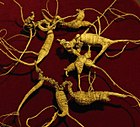Note: This is a project under development. The articles on this wiki are just being initiated and broadly incomplete. You can Help creating new pages.
Panax quinquefolius - American ginseng
Panacis quinquefolis is a herbaceous perennial plant in the ivy family, commonly used as Chinese or Herbal medicine. An extract is sold as Cold-fX. It is native to eastern North America, though it is also cultivated in places such as China.
Uses
Parts Used
Chemical Composition
Like Panax ginseng, American ginseng contains dammarane-type ginsenosides, or saponins, as the major biologically active constituents. Dammarane-type ginsenosides include two classifications: 20(S)-protopanaxadiol (PPD) and 20(S)-protopanaxatriol (PPT). American ginseng contains high levels of Rb1, Rd (PPD classification), and Re (PPT classification) ginsenosides—higher than that of P. ginseng in one study.[1]
Common names
| Language | Common name |
|---|---|
| Kannada | Ativisa |
| Hindi | Atis |
| Malayalam | Ativisam |
| Tamil | Atividyam |
| Telugu | Ati visa |
| Marathi | NA |
| Gujarathi | NA |
| Punjabi | NA |
| Kashmiri | NA |
| Sanskrit | Ativisha |
| English | Indian Atees |
Habit
Identification
Leaf
| Kind | Shape | Feature |
|---|---|---|
| simple | ovel |
.
Flower
| Type | Size | Color and composition | Stamen | More information |
|---|---|---|---|---|
| Unisexual | 2-4cm long | white–violet | 10-18 | Flowers are Large, hooded and occur in slender racemes or lax leafy panicles. Corolla is hairy. Carpels are five in number |
Fruit
| Type | Size | Mass | Appearance | Seeds | More information |
|---|---|---|---|---|---|
| 7–10 mm (0.28–0.4 in.) long pome | s | {{{6}}} |
Other features
List of Ayurvedic medicine in which the herb is used
- Vishatinduka Taila as root juice extract
Where to get the saplings
Mode of Propagation
How to plant/cultivate
Ginseng has fairly stringent environmental requirements. It requires at least 70 percent shade. The soil must have enough base nutrients (15-20 percent base saturation) to meet its needs, but not so much that the soil pH exceeds 6 (liming is out of the question unless pH is too low). The soil must be moist, but well-drained. To achieve this, the organic matter content has to be pretty high.[2]
Commonly seen growing in areas
Photo Gallery
References
[External Links
- Pages that are stubs
- Ayurvedic Herbs known to be helpful to treat Stress management
- Ayurvedic Herbs known to be helpful to treat Mental clarity
- Ayurvedic Herbs known to be helpful to treat Menopause
- Ayurvedic Herbs known to be helpful to treat Type 2 Diabetes
- Ayurvedic Herbs known to be helpful to treat Heart disease
- Ayurvedic Herbs known to be helpful to treat Cancer
- Ayurvedic Herbs known to be helpful to treat Alzheimer
- Herbs with Root used in medicine
- Herbs with Leaves used in medicine
- Herbs with common name in Kannada
- Herbs with common name in Hindi
- Herbs with common name in Malayalam
- Herbs with common name in Tamil
- Herbs with common name in Telugu
- Herbs with common name in Sanskrit
- Herbs with common name in English
- Habit - herb
- Index of Plants which can be propagated by Seeds
- Herbs that are commonly seen in the region of well-drained soil
- Herbs that are commonly seen in the region of sandy soil
- Herbs








